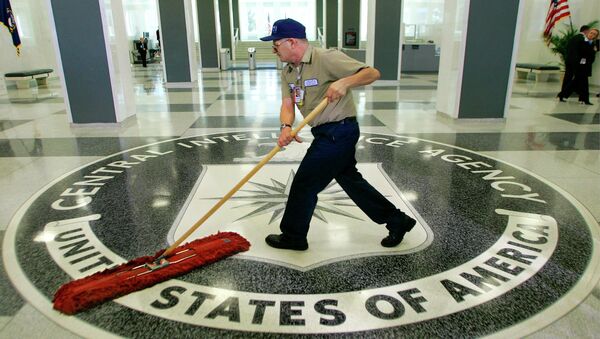[Note to readers: the following contains graphic material.]
1. Waterboarding is, in fact, torture.
Waterboarding induced “convulsions and vomiting” when practiced on prisoners. The CIA’s first detainee, Abu Zubaydah, was subjected to this tactic and, at one point, became “completely unresponsive, with bubbles rising through his open, full mouth.”
Investigators waterboarded Khalid Sheikh Mohammed 183 times, resulting in what the report called “a series of near drownings.”
So, yes, Dick Cheney, waterboarding very much is torture.
2. Sleep deprivation is no way to get information.
Then there was the sleep deprivation, wherein CIA agents kept detainees awake for more than a week. At least five detainees reported hallucinating but were kept standing with their arms shackled overhead, often naked.
After being kept awake for 56 hours, detainee Arsala Khan couldn’t speak and was “visibly shaken by his hallucinations depicting dogs mauling and killing his sons and family.”
It’s unclear how investigators thought they would get reliable information from detainees who were hallucinating.
3. Rectal feeding is a thing.
In a revelation certain to break the internet, the document reported that “At least five CIA detainees were subjected to ‘rectal rehydration’ or rectal feeding.” In the case of Majid Khan, his “lunch tray," which consisted of “hummus, pasta with sauce, nuts, and raisins was ‘pureed’ and rectally infused.”
4. They tortured innocent people.
“At least 26 [detainees] were wrongfully held. Detainees often remained in custody for months after the CIA determined they should not have been detained… These included an ‘intellectually challenged’ man whose CIA detention was used solely as leverage to get a family member to provide information.” The CIA assessed the family member “to be connected to al-Qa'ida based solely on information fabricated by a CIA detainee.”
5. Interrogators threatened detainees’ families.
From the report: “CIA officers also threatened at least three detainees with harm to their families— to include threats to harm the children of a detainee, threats to sexually abuse the mother of a detainee, and a threat to ‘cut [a detainee's] mother's throat.’"
There were also threats of sodomy with a mop handle and regular threats of death.
6. Detainees had major psychological breakdowns.
“Throughout the program, multiple CIA detainees who were subjected to the CIA's enhanced interrogation techniques and extended isolation exhibited psychological and behavioral issues, including hallucinations, paranoia, insomnia, and attempts at self-harm and self-mutilation. Multiple psychologists identified the lack of human contact experienced by detainees as a cause of psychiatric problems,” the report says.
7. The CIA lied about the program’s effectiveness.
The report says that the CIA underplayed the brutality of the program while making false claims about its effectiveness as a way of limiting oversight over the program and ensuring that it continued to run.
The CIA claimed that more than 20 terrorist plots had been foiled using information obtained from torture, but the report found that all useful information either came before the torture tactic was employed, or was used only to corroborate information the CIA already knew.
In fact, the report notes that much of the information obtained through torture turned out to be fabricated by detainees who just wanted the pain to stop.
8. They tortured their own people.
Two detainees were transferred to CIA custody and shackled into the “standing sleep deprivation position” while they were questioned. CIA officers were looking for inconsistencies in their stories.
After 24 hours, CIA Headquarters informed the interrogators that the men were CIA assets, former informants.
“The two detainees had tried to contact the CIA on multiple occasions prior to their detention to inform the CIA of their activities and provide intelligence.”
Oops.
9. CIA interrogators raised objections.
On multiple occasions, CIA staffers questioned the manner of their interrogations, but were told by their supervisors to continue. CIA correspondence reveals that the torture “had a profound effect on all staff members present… it seems the collective opinion that we should not go much further… everyone seems strong for now but if the group has to continue… we cannot guarantee how much longer.”
Later, "Several on the team profoundly affected… some to the point of tears and choking.”
At least one interrogator showed he knew what he was doing when he told a detainee he would never get out of the prison alive because “we can never let the world know what I have done to you.”
10. It pays to create psychological torture programs.
Two psychologists contracted by the CIA were paid $81 million to devise the enhanced interrogation techniques and play a central role in the operation, assessments, and management of the CIA's Detention and Interrogation Program.
“Neither psychologist had any experience as an interrogator, nor did either have specialized knowledge of al-Qa'ida, a background in counterterrorism, or any relevant cultural or linguistic expertise,” the report notes.
“On the CIA's behalf, the contract psychologists developed theories of interrogation based on 'learned helplessness,' and developed the list of enhanced interrogation techniques that was approved for use against Abu Zubaydah and subsequent CIA detainees.”
11. And that's just part of hundreds of millions in expenses.
CIA records indicate that the CIA’s Detention and Interrogation Program cost well over $300 million in non-personnel costs. This includes funding for the construction and maintenance detention facilities, including facilities “that were never used, in part due to host country political concerns.”
12. This is probably just the tip of the iceberg.
On Tuesday, the Senate intelligence committee released only 500 pages of a summary of a report that exceeds 6,000 pages.
On top of that, the White House and the CIA declined to give the committee more than 9,000 documents that they requested.
How bad does the content of those documents have to be to remain classified?


